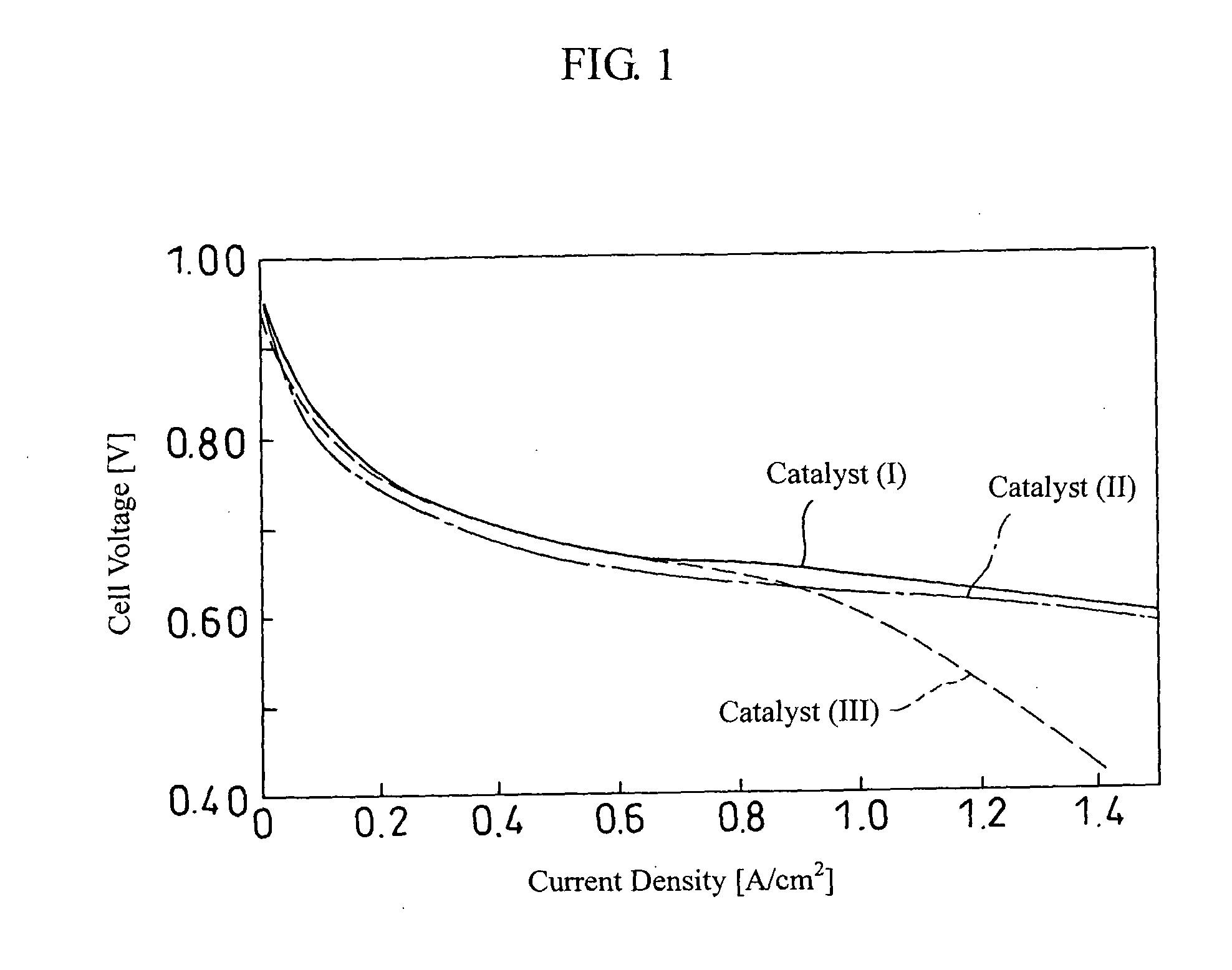Electrode Catalyst for Fuel Cell and Fuel Cell
a fuel cell and electrode catalyst technology, applied in the direction of physical/chemical process catalysts, cell components, metal/metal-oxide/metal-hydroxide catalysts, etc., can solve the problems of increasing the amount of generated water, reducing the voltage of the cell during long-hour operation, and affecting the performance of the cell, so as to achieve the effect of reducing the voltage in the high current region, improving water-drainage performance, and suppressing the phenomenon of flooding
- Summary
- Abstract
- Description
- Claims
- Application Information
AI Technical Summary
Benefits of technology
Problems solved by technology
Method used
Image
Examples
examples
[0029] Examples and Comparative Examples of the present invention will be hereafter described.
example 1
[0030] Commercially available carbon black powder having a specific surface area of approximately 1000 m2 / g (50g) was added to 0.5 liter of pure water and allowed to disperse therein. To the resulting dispersion solution, a chloroplatinic acid solution containing 5.0 g of platinum was added dropwise and allowed to blend sufficiently with carbon. Then, the solution was neutralized with an ammonia solution, followed by filtration. Next, the resulting cake obtained above was allowed to disperse again uniformly in a liter of pure water. A dispersion solution prepared by dissolving cobalt nitrate comprising 0.5 g of cobalt in 0.1 l of pure water was added dropwise to the solution. The obtained solution was neutralized with an ammonia solution, followed by filtration. The thus obtained cake was vacuum dried at 100° C. for 10 hours. Thereafter, the resultant was subjected to alloy treatment at 600° C. for 6 hours in an argon atmosphere in an electric furnace. The thus obtained catalyst sub...
example 2
[0034] Catalyst A (10 g) was agitated in a litter of a nitric acid solution (3 mol / l) and retained in the solution having a temperature of 90° C. for an hour, followed by filtration. The thus obtained cake was vacuum dried at 100° C. for 10 hours. Thereafter, the resultant was reduced at 100° C. for an hour in a hydrogen atmosphere in an electric furnace, such that catalyst powder (II) was obtained.
[0035] As in the case of Example 1, physical properties of the catalyst were determined. The catalyst particle size was found to be 3.7 nm, the quantity of basic surface functional groups was found to be 62 meq, the pH value in water was found to be 6.8, and the specific surface area was found to be 378 m2 / g.
PUM
| Property | Measurement | Unit |
|---|---|---|
| particle diameter | aaaaa | aaaaa |
| current density | aaaaa | aaaaa |
| particle diameter | aaaaa | aaaaa |
Abstract
Description
Claims
Application Information
 Login to View More
Login to View More - R&D
- Intellectual Property
- Life Sciences
- Materials
- Tech Scout
- Unparalleled Data Quality
- Higher Quality Content
- 60% Fewer Hallucinations
Browse by: Latest US Patents, China's latest patents, Technical Efficacy Thesaurus, Application Domain, Technology Topic, Popular Technical Reports.
© 2025 PatSnap. All rights reserved.Legal|Privacy policy|Modern Slavery Act Transparency Statement|Sitemap|About US| Contact US: help@patsnap.com

